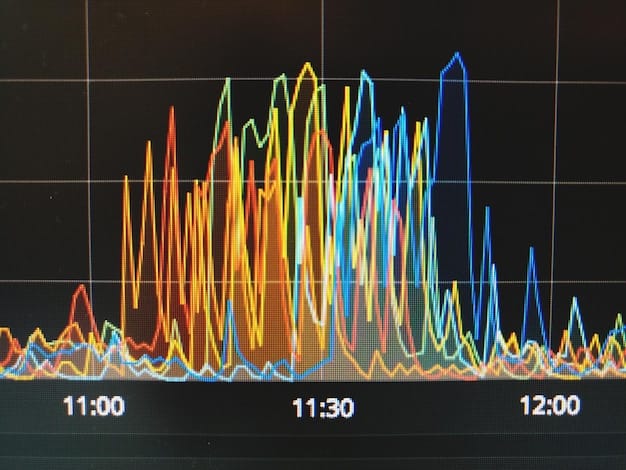Battery Storage for Solar: Is It Worth the Investment in 2025?

Battery storage for solar power in 2025 involves evaluating the financial benefits, considering factors like reduced energy costs, grid independence, and potential government incentives against the upfront investment and ongoing maintenance expenses.
As we approach 2025, the question of whether battery storage for solar is a worthy investment becomes increasingly relevant. With advancements in technology and evolving energy policies, understanding the financial implications is crucial for homeowners and businesses alike.
Understanding the Basics of Solar Battery Storage
Solar battery storage systems allow you to store excess energy generated by your solar panels during the day for use later, such as during the night or on cloudy days. This helps to maximize the benefits of your solar investment and reduce reliance on the grid.
How Solar Batteries Work
Solar batteries, typically lithium-ion, store DC electricity generated by solar panels. An inverter converts this DC electricity to AC electricity for use in your home. When the solar panels aren’t producing enough power, the battery supplies the stored energy.
Types of Solar Batteries Available
Several types of solar batteries are available, including lithium-ion, lead-acid, and flow batteries. Lithium-ion batteries are the most popular due to their high energy density, long lifespan, and relatively low maintenance requirements.
- Lithium-Ion Batteries: High energy density, long lifespan, minimal maintenance.
- Lead-Acid Batteries: Lower cost, shorter lifespan, requires regular maintenance.
- Flow Batteries: Long lifespan, suitable for large-scale storage, higher upfront cost.
Solar battery storage is a game-changer, offering more control over your power usage and potentially significant savings. Let’s delve into a financial breakdown to ascertain its worth in 2025.

The Initial Costs of Solar Battery Storage in 2025
The initial cost is a significant factor when considering solar battery storage. This includes the cost of the battery itself, as well as installation fees and any necessary upgrades to your existing solar panel system.
Battery Costs
The cost of a solar battery depends on its capacity, type, and manufacturer. In 2025, you can expect to pay between $7,000 and $18,000 for a typical residential battery system, including installation.
Installation Costs
Installation costs can range from $1,000 to $3,000, depending on the complexity of the installation and the installer’s rates. Factors influencing installation costs include the location of the battery, wiring requirements, and any necessary electrical panel upgrades.
- Battery Type: Lithium-ion batteries generally have a higher upfront cost.
- Capacity: Larger capacity batteries come with a higher price tag.
- Installation Complexity: Intricate installations can increase labor costs.
Understanding these upfront costs is essential. However, it’s just the beginning; the long-term savings and benefits are where the real value lies.
Quantifying the Financial Benefits of Solar Battery Storage
After covering the upfront costs, it’s essential to understand the financial benefits associated with solar battery storage. These benefits can include reduced energy bills, increased energy independence, and potential revenue from grid services.
Reduced Energy Bills
By storing solar energy during the day and using it during peak hours when electricity prices are highest, you can significantly reduce your energy bills. The amount of savings depends on your energy consumption patterns and your utility’s rate structure.
Net Metering vs. Battery Storage
In areas with net metering, excess solar energy is sent back to the grid, and you receive credit on your bill. However, battery storage allows you to use that energy directly, avoiding any grid dependence. This becomes particularly advantageous when net metering policies are less favorable.

Let’s explore the cost/benefits in more detail:
- Peak Shaving: Use stored energy during peak demand to avoid high prices.
- Backup Power: Provides power during outages, increasing energy security.
- Grid Services: Earn revenue by providing grid support services.
By quantifying these benefits, one can get a clearer picture of the potential return on investment in solar battery storage. Each factor adds a unique component to the overall financial advantage.
Government Incentives and Rebates for Battery Storage
Government incentives and rebates can significantly offset the initial costs of solar battery storage, making it a more attractive investment. These incentives vary by location and may include tax credits, rebates, and grants.
Federal Tax Credits
The federal solar tax credit, also known as the Investment Tax Credit (ITC), allows you to deduct a percentage of the cost of your solar panel system and battery storage from your federal taxes. In 2025, the ITC is expected to remain at 26% for systems placed in service, offering substantial savings.
State and Local Incentives
Many states and local governments offer additional incentives for solar battery storage. These incentives can include rebates, tax credits, and grants. Check your state’s energy office or local utility company for available programs.
This is very helpful:
- State Rebates: Direct cash rebates for battery storage installations.
- Local Grants: Funding for energy efficiency upgrades, including battery storage.
- Tax Exemptions: Sales tax exemptions on solar and battery storage equipment.
Government incentives are a crucial piece of the puzzle. They not only reduce the initial financial burden, but they also signify a broader commitment to renewable energy and grid stability.
Long-Term Maintenance and Replacement Costs
While solar batteries require less maintenance than other energy storage options, it’s essential to factor in long-term maintenance and replacement costs when evaluating the financial viability of solar battery storage.
Battery Lifespan
Most solar batteries have a lifespan of 5 to 15 years, depending on the type and usage. Lithium-ion batteries generally have a longer lifespan compared to lead-acid batteries. Proper maintenance can also extend the battery’s life.
Replacement Costs
When the battery reaches the end of its lifespan, it will need to be replaced. Replacement costs can be significant, potentially ranging from $5,000 to $10,000, including installation. Factor this cost into your long-term financial planning.
Important points to keep in mind:
- Warranty: Check the manufacturer’s warranty for coverage on defects and performance.
- Maintenance: Regular inspections and maintenance can prolong lifespan.
- Recycling: Consider recycling costs and disposal regulations.
Maintenance and replacement costs are inevitable aspects of owning a solar battery system. However, with proper planning and maintenance, one can mitigate the financial impact and maximize the long-term value of the investment.
Is Solar Battery Storage Right for You in 2025?
Deciding whether solar battery storage is a worthwhile investment in 2025 depends on your individual circumstances and financial goals. Consider your energy consumption patterns, utility rates, available incentives, and long-term financial outlook.
Factors to Consider
Several factors can influence the financial viability of solar battery storage for your situation. These include your energy usage, location, utility rates, and eligibility for government incentives.
Making the Decision
To make an informed decision, evaluate your energy needs, compare the costs and benefits of solar battery storage, and consult with a qualified solar installer. A comprehensive financial analysis can help you determine whether solar battery storage is a smart investment for you.
Check the list here:
- Energy Consumption: High energy users benefit most from battery storage.
- Utility Rates: Areas with high peak-hour rates see greater savings.
- Incentives: Maximizing available incentives lowers upfront costs.
Assessing whether solar battery storage is ideal involves a thorough evaluation of one’s unique energy profile, financial objectives, and local regulations. With the right approach, you can determine whether this investment aligns with your needs and contributes to a sustainable future.
| Key Aspect | Brief Description |
|---|---|
| 💡 Initial Costs | Ranges from $7,000 to $18,000 including installation, based on battery type and capacity. |
| 💰 Financial Benefits | Includes reduced energy bills, energy independence, and potential grid service revenue. |
| ☀️ Gov. Incentives | Federal tax credits (ITC) and state/local rebates can offset initial costs significantly. |
| 🔋 Maint. & Replace. | Batteries last 5-15 years; replacement can cost $5,000-$10,000. Regular maintenance is crucial. |
Frequently Asked Questions
▼
Most solar batteries, especially lithium-ion, last between 5 to 15 years, depending on usage and maintenance. Regular inspections can help prolong the battery’s lifespan.
▼
Savings vary depending on your energy consumption, utility rates, and net metering policies. Storing energy for peak hours can significantly reduce costs.
▼
Yes, the federal Investment Tax Credit (ITC) and various state and local incentives can help offset initial costs. Check local energy programs for specific details.
▼
The main types include lithium-ion, lead-acid, and flow batteries. Lithium-ion is the most popular due to its high energy density and long lifespan.
▼
Even with net metering, battery storage offers benefits by allowing you to use your stored energy directly and providing backup power during outages, adding value.
Conclusion
In conclusion, the decision of whether to invest in battery storage for solar in 2025 hinges on a comprehensive evaluation of upfront costs, potential savings, government incentives, and individual energy needs. As technology advances and policies evolve, carefully weighing these factors is crucial to making an informed choice that aligns with both financial goals and a commitment to sustainable energy.





